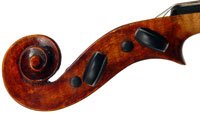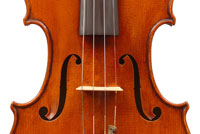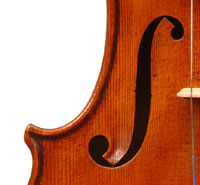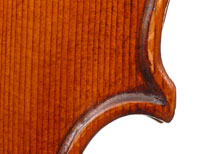|
Ref : 0846
A good trade copy of Stradivari
|

go to Home Page see more Violins |
This violin is unlabelled and undated, but seems to be of German origin from around 1920 to 1930. It follows the Stradivari pattern closely and in general appearance seems to have been intended as a deliberately copy of the master's work. It is really attractive and nicely made of appealing materials. It represents high-end German trade work but of unknown origin.The two-piece back is unassuming but nevertheless of subtle charm, made of mildly and unevenly flamed maple with a broad curl. It appears that the same wood was used in the sides, neck and scroll. The top is of superb tone spruce with very straight and even growth lines, very closed on the centre seam and opening more to the flanks. There is great attention to detail in the Fs, purfling and corners, with the Fs being crisp and tidy and the palettes nicely fluted - a sign of good workmanship. The finish on the inside is clean and correct. The scroll is elegant, almost feminine and well-balanced. The varnish in the top is a nice golden brown with a tinge of red. In the back, sides and scroll the reddishness predominates. The varnish is highly transparent, complimenting the beauty of the materials, particularly in the front. This instrument is in very good condition.
This violin is a good example of the quality of workmanship that emerged from high-end trade studios in Europe during the first part of the 20th century, in which a real effort was made to make good instruments accessible to those who could not pay a fortune for a violin. Those instruments, produced mainly in Germany and France, are highly esteemed today and fill an important niche in the violin world.
Adding to the appeal of the violin is it tone - it is well-toned throughout the register.
 |
 |
 |
||
 |
Dimensions : Standard full size Stradivari model.
Length of back: 35.7 cm
Condition : Excellent condition. A wingcrack on each F-hole has been repaired and is virtually invisible. Three small anomalies in the back near the neck button have been filled inconspicuously and do not detract from the overall appeal and charm of this violin.
Provenance : Withheld
Price : P.O.A.
 |
 |
 |
 |
 |
 |
 |
 |
 |
 |
 |
 |
|||||
 |
 |